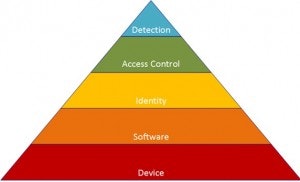In a previous blog I discussed why it is important to focus on the endpoint first when it comes to security. This generated some really interesting discussions with people arguing the case for product X and Y or asking “what about detection on the endpoint?”
Many rightly pointed out that the problems of detection and evasion apply to the endpoint as well as the network. When relying on detection solutions the trade-off between usability and security applies to endpoints just as much as the network. When it comes to any of these solutions I’m not saying you shouldn’t implement these technologies at all, what you should do is prioritise and think of security holistically.
The key thing is that there is no point investing in the latest and greatest detection product, either on the network or endpoint, if you have no control over the device, software or the user. As with most things in life if you get the foundations right you can build a stable secure platform. If you don’t you risk instability and years of constant costly remediation.
A recent Microsoft TechNet blog discussed this same principle, calling it the Hierarchy of Cyber Needs. The concept is straight forward, to get the most benefit from security products you need to identify and prioritise investment in layers of security. This starts from the device and works upwards through the software, identity and access control, only layering on detection at the final stage.

What does this mean in the real world? It means don’t be the organisation that spends millions on network defences only to be breached by an admin user opening an unknown malicious attachment. Organisations often lose sight of these priorities and start jumping to detection solutions as the answer to combating APTs. In reality robust privilege management and application control are far more essential to defend against these threats which are often built to evade detection and analysis.
When security is properly prioritised the cumulative benefits are greater than the sum of the individual parts. It is far more useful to subscribe to threat intelligence feeds when you have control of the endpoints to actually take action such as blocking applications or isolating content. It is also better to not flood a network detection solution with thousands of possible events because users are free to install and run unknown software, allowing incident response teams to focus not fire fight.
Thinking of security holistically and properly prioritising investment and resource is not just a benefit to security it is also the most cost effective way to build your cyber defences as each layer benefits the next. So if you find yourself lost in a sea of InfoSec jargon trying to decide between X and Y take a step back and consider your hierarchy of cyber needs. It may just be the case that you need to focus on the foundations first.

James Maude, Field Chief Technology Officer
James Maude is the Field Chief Technology Officer (FCTO) at BeyondTrust. With his broad experience in security research, both in academia and industry, James has spent the past decade analyzing cyber threats to identify attack vectors and trends in the evolving security landscape. He is an active member of the security community and hosts Adventures of Alice and Bob, a podcast that shines a light on the people making a difference in security. As an expert voice on cybersecurity, he regularly presents at international events and hosts webinars to discuss threats and defense strategies.








